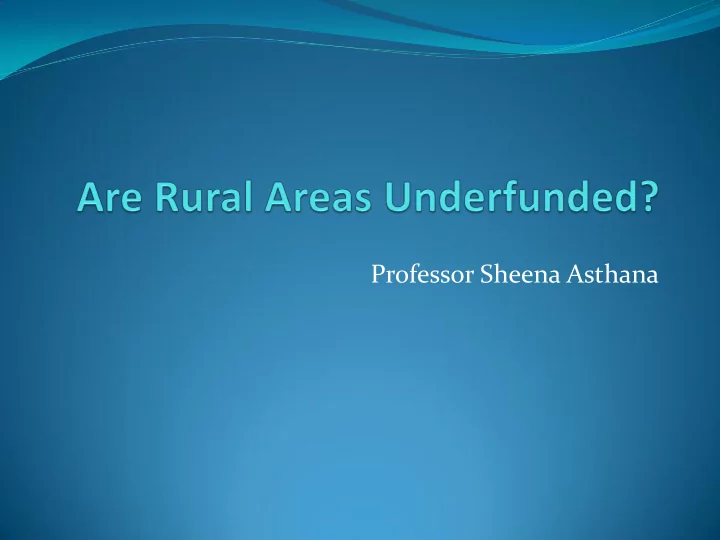

Professor Sheena Asthana
Outline Problem: what problem? Resource allocation: a brief overview So, are rural areas underfunded?
Problem: what problem?
Widespread perception that urban deprived areas have the highest ‘needs’ for NHS services (and have been systematically underfunded) Data interpretation issues Standardised vs unadjusted measures Inverse correlation between deprivation & demography Distribution of ‘needs’ for health care equity and health care varies
Synthetic estimates of premature and all age prevalence of CVD Males, 45-64 All people Self-Reported CVD Self-Reported CVD 20% and above 14% and over 18% - 20% 12% - 14% 16% - 18% 10% - 12% 14% - 16% 8% - 10% Less than 14% Less than 8%
The prevalence of most chronic diseases has a more pronounced demographic than socio-economic gradient 23% of the rural population are over retirement age compared to 18% in urban areas As a result, overall (crude) rates of disease, disability and mortality tend to be higher in rural areas Does the resource allocation system reflect this?
RA: a brief history Dominance of the ‘utilisation - based’ approach Assumes that historical patterns of use are appropiate – or that unmet need/unjustified supply can be isolated (highly doubtful!) Inherent circularity (as models are developed in order to maximise best fit with past utilisation) AREA formula (2009-09) resulted in a significant shift in resources towards urban deprived areas (which were widely reported to be under DFT) Technical flaws: ‘data mining’, selective approach to unmet need, two stage model (in which age and additional needs indices opposed each other)
Sequentially Incorporated factors in AREA Capitation Formula
Age and deprivation are negatively correlated in England. Thus, the indices tended to oppose each other PCTs with more ageing populations would usually have been better off if there were no weightings at all! 2007 CARAN review: age and additional needs calculated in a one-stage model, stratified by age Confirmed suspicions that the AREA formula had overestimated the health care needs of younger deprived and urban areas and underestimated the needs of demographically older and rural areas.
‘Needs Only' CARAN Allocations relative to AREA -based Baseline Allocations; by Urban/Rural Category
PCT-level Geography of Gain/Loss on the Implementation of 'Needs Only' CARAN Allocations relative to the AREA-based Baseline Allocations Change of Allocation Gain of 10% or more Gain of 2% - 10% Unchanged (-2% to +2%) Loss of 2% - 10% Loss of 10% or more
Little change in overall allocations as gap between CARAN and AREA allocations was filled with a new ‘Health Inequalities’ adjustment (which exceeded 20% of total funding in several urban PCTs)
Per capita Health Inequalties Allocation Per capita Health Inequalities Allocation £350 or above £250 - £350 (2010-11) £200 - £250 £150 - £200 Less than £150
New acute formula (2011-) in line with CARAN (but assigns a higher level of need to younger populations) HI adjustment changed from 15-10% in 2011/12. 10 most deprived PCTs have gone from being 2.7% below target in 2007/8 to 5.2% above target.
Mortality, morbidity and allocations for PCTs with the youngest and oldest demographies, 2010-11 Crude Mortality Rate (per 100,000) Average All Cause Deprivation Score Standardised Circulatory % GP patients on Cancer spend per Per Capita Allocation Primary care trust %pop >75 (IMD2010) Mortality Ratio (SMR) All Cause Cancer Disease cancer register cancer patient (2010-11) Dorset PCT 12.7% 14.6 1,159.1 334.0 399.4 2.49% £1,560.50 84.5 £4,075 Hastings and Rother PCT 12.1% 26.8 1,275.8 374.5 486.0 2.01% £1,836.98 98.5 £6,282 East Sussex Downs and Weald 11.9% 16.7 1,210.4 310.8 456.1 2.08% £1,603.68 PCT 88.1 £5,784 Torbay Care Trust 11.7% 26.8 1,281.7 341.2 432.9 2.07% £1,747.03 97.4 £5,000 :: :: :: :: :: :: :: :: :: :: City and Hackney Teaching PCT 3.9% 41.3 494.1 138.6 168.2 0.91% £2,235.39 97.3 £9,996 Camden PCT 3.8% 25.4 480.1 146.7 154.2 1.16% £1,881.29 93.6 £15,890 Newham PCT 3.5% 41.8 539.7 148.4 187.6 0.62% £2,116.47 114.5 £11,080 Tower Hamlets PCT 3.4% 39.6 441.4 136.6 146.6 0.77% £2,084.35 109.7 £13,087
Are rural areas underfunded? Continued mismatch between underlying morbidity and allocation of resources? Problem reinforced by variation in expenditure on adult social care E.g. Tower Hamlets spent £2,551.69 on each person aged 65 or more in 2009-10, nearly five times more than Cornwall (£520.12). On average, the twelve Inner London Boroughs spent £1,750 per person aged 65+ compared to just £773 per capita across the 27 Shire Counties.
Charges for home care are statistically higher in authorities with older populations and a larger percentage of people living in rural settlements There is gross inequality in the indicative personal budgets that identical individuals would receive from different councils. £16 to £331 for person A and from £41 to £410 for person B LAs with higher per capita expenditure on social care are able to offer significantly more generous indicative budgets than poorer funded LAs.
Conclusion Evidence of institutionalised ageism in the resource allocation system with rural implications Little scope for redistribution in an age of austerity (though signs that ACRA may be willing to adjust for unavoidable additional costs associated with rurality) Little political will to redistribute due to consequences of taking resources away from deprived areas We must challenge a discourse that implies that being old, poor and/or excluded is less of a problem in the countryside than the city because it is such a nice place to live!
Recommend
More recommend